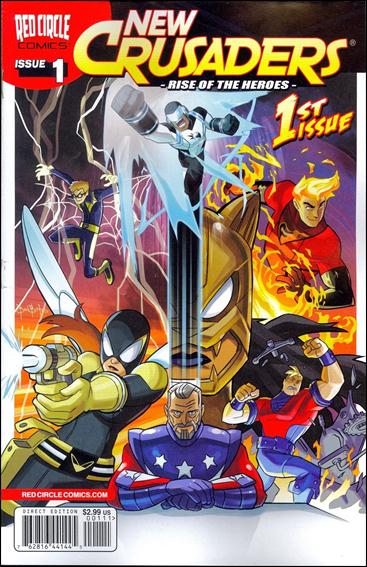Comic Book Review: New Crusaders #1: Rise of the Heroes written by Ian Flynn, pencils by Ben Bates & Alitha Martinez, inks by Gary Martin
It was supposed to be a fun reunion picnic for the founders of the small town known as Red Circle and their children. After all, their efforts as the Mighty Crusaders had made the world a better place, free from supervillains and major crime. They’d earned a long rest as normal people, building a community and raising families. Even Joe Higgins, who’d never fully relaxed, showed up for once. But a menace once thought dead has returned, and dark days are ahead. The world will need new heroes, the New Crusaders!

Back in 1939, MLJ Publications (named after the initials of its three founders) began publishing comic books, mostly humor and adventure. Their first superhero, Bob Phantom, appeared in the second issue they published, but they didn’t really gain traction until the Shield, comics’ first patriotic superhero, appeared in Pep Comics in 1940. (He’d soon be overshadowed by Timely Comics’ Captain America.) Other superheroes appeared as well, including the Comet (who was the first superhero to “permanently” die, and was succeeded by the Hangman) and the Black Hood.
In 1941, Pep Comics got a new feature inspired by the Andy Hardy movies, starring a goofy teenager named Archie Andrews. As time went on, and as the superhero craze faded post-World War Two, Archie took over more and more of Pep, and then the company, which renamed itself Archie Comics.
With the resurgence of superhero popularity in the 1960s, Archie Comics revived some of its old characters, created a new version of the Shield, and created new heroes like the Fly and Jaguar. Their team book was The Mighty Crusaders. Sales weren’t that hot, so those books folded, but the characters were fun and many people remembered them fondly, so there have been multiple revivals over the years by various imprints.
For this 2013 version, there’s a loose continuity to previous versions, but nothing from specific stories should be relied upon. Brain Emperor, one of the Crusaders’ more iconic villains, attacks the picnic and most of the retired heroes vanish presumed dead. Joe Higgins, the Shield, manages to get their children to a safe house, and informs them that they will need to become the next generation of heroes, a task he’s been preparing for since before they were born.
This isn’t going to be easy. The kids were never told of their parents’ or mentor’s superhero days, so they’re immediately suspicious and unprepared. Ivette Velez, the new Jaguar, must come to terms with the ancient god that grants her powers. Alex Tyler, the new Fireball, and Greg Dickering, the new Comet, ingest their superserums directly before they can be told that they’re for external use only. And Johnny Sterling flinches at the prospect of being dipped in a nanofluid that will turn him into the new “Steel” Sterling.
But not all the new heroes are having it quite that rough. Kelly Brand, the new Fly Girl, gets technological gear that mimics her mother’s magitek abilities, and Wyatt Raymond, the new Web, actually had a sensory superpower to begin with, unlike his parents. They just need lots of training.
After a couple of weeks, Brain Emperor gets tired of waiting for the Shield to be found, so decides to move on with the next step of his master plan, getting minions. As it happens, a bunch of supervillains have been locked up for years in Zenith Penitentiary near Impact City, so he heads there to free them. This will be the test by fire for the New Crusaders!
Our young heroes get some unexpected help; some of the prisoners are in fact violent vigilante heroes who were put away because killing criminals is still murder. They’re more than willing to help fight the rioting inmates.
The New Crusaders manage to keep the majority of inmates from escaping, but the Brain Emperor and several lackeys get away–and the Crusaders must now face their first team tragedy!
There’s lots of references to the Mighty Crusaders’ previous publishing history–long-time fans will already have spotted several. Indeed, much of the pleasure of this series is all the nostalgia. The art is comic-booky, which works just fine.
I do need to point out there’s a lot of traumatic events in this volume, most of which are dealt with by the traditional superhero method of going out and punching bad guys. At no time is it mentioned that these kids might need some counseling or other mental health boosting. Thus I think it might be suited best to older teens.
Recommended primarily to fans of previous Crusader appearances, but most fans of brightly-colored superhero stories should be able to enjoy it.

